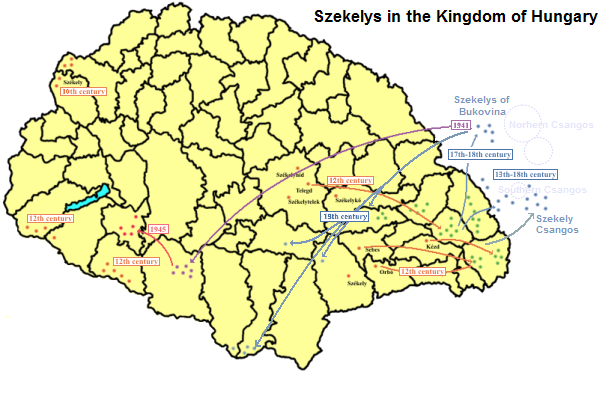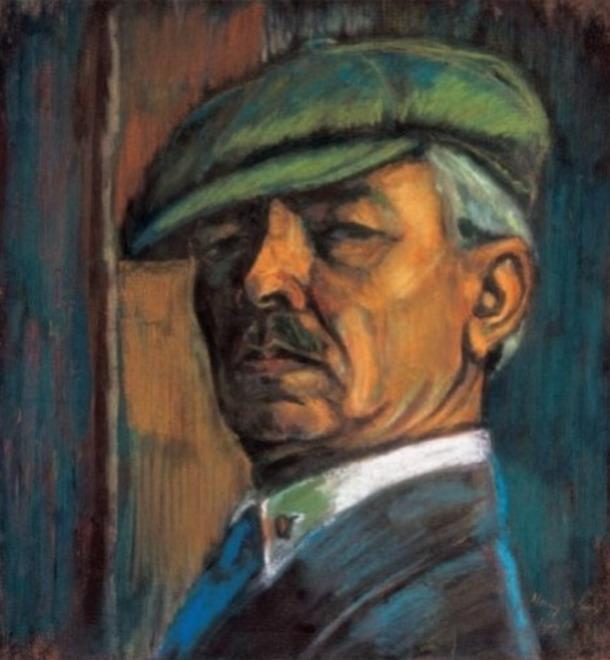|
Hosasău
Leliceni ( hu, Csíkszentlélek or colloquially ''Szentlélek'', meaning "Holy Spirit", Hungarian pronunciation:) is a commune in Harghita County, Romania. It lies in the Székely Land, an ethno-cultural region in eastern Transylvania. Component villages The commune is composed of four villages: History The main village was first mentioned in 1251 by its Hungarian name as ''castrum Zenth Lelewk''. In 1602, it was recorded as ''Szentlélek'' and in 1913 as ''Csikszentlélek''. Its original Romanian names was ''Cic-Sânlelec'' which was later Romanianized to the current official name. Transylvanian Toponym Book The villages forming the commune belonged to di ... [...More Info...] [...Related Items...] OR: [Wikipedia] [Google] [Baidu] |
Fitód
Leliceni ( hu, Csíkszentlélek or colloquially ''Szentlélek'', meaning "Holy Spirit", Hungarian pronunciation:) is a commune in Harghita County, Romania. It lies in the Székely Land, an ethno-cultural region in eastern Transylvania. Component villages The commune is composed of four villages: History The main village was first mentioned in 1251 by its Hungarian name as ''castrum Zenth Lelewk''. In 1602, it was recorded as ''Szentlélek'' and in 1913 as ''Csikszentlélek''. Its original Romanian names was ''Cic-Sânlelec'' which was later Romanianized to the current official name. Transylvanian Toponym Book The villages forming the commune belonged to Csíkszék district until the administrative reform of Transylvania in 1876, when they fell within the Csík County in the Kingdom ... [...More Info...] [...Related Items...] OR: [Wikipedia] [Google] [Baidu] |
Sâncrăieni
Sâncrăieni ( hu, Csíkszentkirály or colloquially ''Szentkirály'', Hungarian pronunciation: , german: Heilkönig, both meaning "holy king" and referring to King St Stephen of Hungary) is a commune in Harghita County, Romania. Composed of a single village, Sâncrăieni, it lies in the Székely Land, an ethno-cultural region in eastern Transylvania. The former Romanian name was ''Ciuc-Sâncraiu''. Geography The village is situated on the two banks of the Olt River at the northernmost end of the Lower Ciuc Basin 7 km from Miercurea Ciuc. It lies just in front of the Jigod pass which divides the Ciuc basin into its upper and lower part. The village is bounded by the foothills of the Ciuc Mountains in the east and by the Harghita range in the west. Demographics The commune has an absolute Székely Hungarian majority. According to the 2002 census it had a population of 6,194 of which 98.13% or 6,078 were Hungarian. In Sâncrăieni proper, the 2002 census reported a popula ... [...More Info...] [...Related Items...] OR: [Wikipedia] [Google] [Baidu] |
Csíkmindszent
Leliceni ( hu, Csíkszentlélek or colloquially ''Szentlélek'', meaning "Holy Spirit", Hungarian pronunciation:) is a commune in Harghita County, Romania. It lies in the Székely Land, an ethno-cultural region in eastern Transylvania. Component villages The commune is composed of four villages: History The main village was first mentioned in 1251 by its Hungarian name as ''castrum Zenth Lelewk''. In 1602, it was recorded as ''Szentlélek'' and in 1913 as ''Csikszentlélek''. Its original Romanian names was ''Cic-Sânlelec'' which was later Romanianized to the current official name. Transylvanian Toponym Book The villages forming the commune belonged to di ... [...More Info...] [...Related Items...] OR: [Wikipedia] [Google] [Baidu] |
Székelys
The Székelys (, Székely runes: 𐳥𐳋𐳓𐳉𐳗), also referred to as Szeklers,; ro, secui; german: Szekler; la, Siculi; sr, Секељи, Sekelji; sk, Sikuli are a Hungarian subgroup living mostly in the Székely Land in Romania. A significant population descending from the Székelys of Bukovina lives in Tolna and Baranya counties in Hungary and certain districts of Vojvodina, Serbia. In the Middle Ages, the Székelys played a role in the defense of the Kingdom of Hungary against the Ottomans in their posture as guards of the eastern border. With the Treaty of Trianon of 1920, Transylvania (including the Székely Land) became part of Romania, and the Székely population was a target of Romanianization efforts. In 1952, during the communist rule of Romania, the former counties with the highest concentration of Székely population – Mureș, Odorhei, Ciuc, and Trei Scaune – were legally designated as the Magyar Autonomous Region. It was superseded in 1960 ... [...More Info...] [...Related Items...] OR: [Wikipedia] [Google] [Baidu] |
Fülöpjakab
Fülöpjakab is a city in Bács-Kiskun county, in the Southern Great Plain region of Hungary. Geography It covers an area of and has a population Population typically refers to the number of people in a single area, whether it be a city or town, region, country, continent, or the world. Governments typically quantify the size of the resident population within their jurisdiction using a ... of 1131 people (2005). Populated places in Bács-Kiskun County {{Bacs-geo-stub ... [...More Info...] [...Related Items...] OR: [Wikipedia] [Google] [Baidu] |
Hungary
Hungary ( hu, Magyarország ) is a landlocked country in Central Europe. Spanning of the Carpathian Basin, it is bordered by Slovakia to the north, Ukraine to the northeast, Romania to the east and southeast, Serbia to the south, Croatia and Slovenia to the southwest, and Austria to the west. Hungary has a population of nearly 9 million, mostly ethnic Hungarians and a significant Romani minority. Hungarian, the official language, is the world's most widely spoken Uralic language and among the few non-Indo-European languages widely spoken in Europe. Budapest is the country's capital and largest city; other major urban areas include Debrecen, Szeged, Miskolc, Pécs, and Győr. The territory of present-day Hungary has for centuries been a crossroads for various peoples, including Celts, Romans, Germanic tribes, Huns, West Slavs and the Avars. The foundation of the Hungarian state was established in the late 9th century AD with the conquest of the Carpathian Basin by Hungar ... [...More Info...] [...Related Items...] OR: [Wikipedia] [Google] [Baidu] |
Pusztaederics
Pusztaederics is a village in Zala County, Hungary Hungary ( hu, Magyarország ) is a landlocked country in Central Europe. Spanning of the Carpathian Basin, it is bordered by Slovakia to the north, Ukraine to the northeast, Romania to the east and southeast, Serbia to the south, Croatia a .... External links Street map Populated places in Zala County {{Zala-geo-stub ... [...More Info...] [...Related Items...] OR: [Wikipedia] [Google] [Baidu] |
Bank Robbery
Bank robbery is the criminal act of stealing from a bank, specifically while bank employees and customers are subjected to force, violence, or a threat of violence. This refers to robbery of a bank branch or teller, as opposed to other bank-owned property, such as a train, armored car, or (historically) stagecoach. It is a federal crime in the United States. According to the Federal Bureau of Investigation's Uniform Crime Reporting Program, robbery is "the taking or attempting to take anything of value from the care, custody, or control of a person or persons by force or threat of force or violence or by putting the victim in fear." By contrast, burglary is "unlawful entry of a structure to commit a felony or theft." Overview Places Bank robbery occurs in cities and towns. This concentration is often attributed to there being more branches in urban areas, but the number of bank robberies is higher than the number of branches. This has advantages both for bank robbers ... [...More Info...] [...Related Items...] OR: [Wikipedia] [Google] [Baidu] |
Attila Ambrus
Attila Ambrus (born October 6, 1967), alias The Whiskey Robber, is a Hungarian bank robber and professional ice hockey player. He became notorious during the 1990s for committing a string of undercover "gentleman robberies" in and around Budapest, Hungary, while working a day job as a goaltender. He became infamous in Hungary as a folk hero symbolic of the times in the decade after the introduction of capitalism to the former Communist state. Ambrus was eventually caught and imprisoned for about 12 years, released in 2012. His story was told in the 2004 book ''Ballad of the Whiskey Robber'' by author Julian Rubinstein and the 2017 film '' A Viszkis'' directed by Nimród Antal. Life and career Ambrus was born in a Székely Hungarian family in Fitod, a small village in eastern Transylvania, Romania, right outside Miercurea Ciuc (''Csíkszereda''). Ambrus had trouble with the law from a young age for committing petty thefts. In 1988, Ambrus illegally crossed Romania's borders by rid ... [...More Info...] [...Related Items...] OR: [Wikipedia] [Google] [Baidu] |
István Nagy (painter)
István Nagy (28 March 1873 – 13 February 1937) was a Hungarian artist who specialized in landscapes and figure painting. Biography A native of Csíkmindszent, Harghita County, Romania, he was born into a land-owning family. Rather than take up agricultural pursuits, he attended the teacher training college in Kolozsvár and taught in Homokmégy.Biography @ Őrőkségűnk (Heritage). One of his courses involved drawing in charcoal. Discovering that he had artistic talent, and encouraged by , he went to study at the |
Jesuit
, image = Ihs-logo.svg , image_size = 175px , caption = ChristogramOfficial seal of the Jesuits , abbreviation = SJ , nickname = Jesuits , formation = , founders = , founding_location = , type = Order of clerics regular of pontifical right (for men) , headquarters = Generalate:Borgo S. Spirito 4, 00195 Roma-Prati, Italy , coords = , region_served = Worldwide , num_members = 14,839 members (includes 10,721 priests) as of 2020 , leader_title = Motto , leader_name = la, Ad Majorem Dei GloriamEnglish: ''For the Greater Glory of God'' , leader_title2 = Superior General , leader_name2 = Fr. Arturo Sosa, SJ , leader_title3 = Patron saints , leader_name3 = , leader_title4 = Ministry , leader_name4 = Missionary, educational, literary works , main_organ = La Civiltà Cattolica ... [...More Info...] [...Related Items...] OR: [Wikipedia] [Google] [Baidu] |
European Tree Of The Year
The European Tree of the Year is an annual contest held to find the most 'loveable tree' in Europe. The contest is held by the Environmental Partnership Association (EPA), an organization supported by the European Land Owners Association and the European Commission. History The European Tree of the Year competition has been running since 2011 and selects a tree from participating countries (now 15 in number) by public vote. It was inspired by an earlier Czech national tree contest. Most countries hold a national poll to select their entrant for each year. Nominations are made in the year preceding the award. Voting for the European tree of the year commences on 1 February each year and lasts until the end of the month. A live, online display of the votes cast for each tree is displayed until the last week in February when final voting figures are kept secret. The winner is announced at an awards ceremony in late March held in the EU Parliament, Brussels. Since 2015, there has ... [...More Info...] [...Related Items...] OR: [Wikipedia] [Google] [Baidu] |






